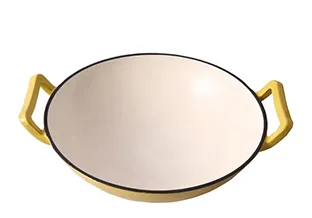
Choosing the Right Material for Your Dutch Oven Cooking Experience
The Importance of Material in Dutch Pot Construction
The Dutch pot, often regarded as a culinary staple in various cultures, is celebrated not only for its versatility but also for the unique properties of its materials. Originating from the Dutch influence on cooking methods, the Dutch pot is typically a heavy, cast-iron or enameled pot that excels in slow cooking. The selection of material is paramount, influencing not only the cooking process but also the final flavor and texture of the dishes prepared. This article explores the different materials used in Dutch pots and their essential roles in culinary excellence.
Cast Iron The Traditional Choice
One of the most beloved materials for Dutch pots is cast iron. Renowned for its excellent heat retention and distribution, cast iron is ideal for slow cooking, which allows flavors to meld beautifully over time. When properly seasoned, cast iron provides a natural non-stick surface and can develop a robust patina that enhances food flavor. This traditional material also has the advantage of being incredibly durable, often lasting generations if well cared for. However, it is essential to maintain cast iron by keeping it dry and seasoned to prevent rusting and ensure longevity.
Enameled Cast Iron A Modern Twist
The introduction of enameled cast iron has revolutionized the Dutch pot, providing an aesthetic appeal alongside high functionality. Enameled cast iron is coated with a layer of enamel, which prevents rust and makes cleaning significantly easier. This layer also allows for acidic food preparation—previously a challenge with uncoated cast iron—without fear of flavor alteration. The enamel comes in various colors, making these pots not only practical but also a beautiful addition to any kitchen. These pots retain the heat retention properties of traditional cast iron but with added protection against wear and tear.
Aluminum A Lightweight Alternative
While cast iron and enameled varieties dominate the market, aluminum Dutch pots have gained popularity due to their lightweight nature and good thermal conductivity. Aluminum heats up quickly and evenly, which is perfect for recipes requiring rapid temperature adjustments. This material is often found in more modern Dutch pot designs, making them easier to handle, especially in busy kitchens. However, aluminum pots typically feature a non-stick coating that can wear over time, necessitating careful use and maintenance.
dutch pot material

Stainless Steel The Versatile Workhorse
Stainless steel Dutch pots are another option, particularly appealing to those seeking a non-reactive and durable material. Although they do not retain heat as well as cast iron, they offer excellent resistance to corrosion and are easy to clean. Stainless steel can vary in quality, so opting for pots with a thick base will ensure better heat distribution and cooking performance. These pots are especially suitable for everyday cooking tasks and are often preferred by home cooks who prioritize maintenance and long-lasting quality over traditional cooking methods.
Ceramic and Non-stick Options
Ceramic Dutch pots provide an alternative for those who prefer a more contemporary look. These pots often have a stylish design and excellent heat retention. However, they are more fragile compared to cast iron or enamel and require careful handling to avoid chipping or breaking. Non-stick Dutch pots made of various materials are also available, catering to the preference for easy cleanup. While non-stick coatings provide convenience, they often sacrifice the longevity and durability associated with traditional materials.
Conclusion Choosing the Right Material
When selecting a Dutch pot, it is crucial to consider the material in relation to cooking style and dish requirements. Cast iron and its enameled variant provide unparalleled heat retention and flavor enhancement, making them ideal for traditional slow cooking. Aluminum offers lightweight alternatives for quick meal preparation, while stainless steel ensures durability and ease of cleaning. Lastly, ceramic and non-stick options cater to the aesthetics and convenience of modern cuisine.
In summary, the material of a Dutch pot profoundly impacts culinary experiences. Understanding the strengths and limitations of each material empowers cooks to choose the perfect pot for their needs, ultimately enhancing their cooking endeavors. Whether preserving traditional cooking methods or embracing modern techniques, the right Dutch pot material can make all the difference in the kitchen.
-
New Cast Iron Skillet w/ Removable Wood Handle - Factory LatestNewsJul.25,2025
-
High Quality Kitchen Durable Black Round Cast Iron Cookware Pancake Crepe Pan-Baixiang County Zhongda Machinery Manufacturing Co., Ltd.|Durability,Non-Stick SurfaceNewsJul.22,2025
-
High Quality Cast Iron Cookware-Pan with Wooden Handle|Durable,Non-Stick,Even Heat DistributionNewsJul.21,2025
-
Cast Iron Pancake Crepe Pan-Durable Kitchenware|Non-Stick&Wooden HandleNewsJul.21,2025
-
Cast Iron Pancake Crepe Pan-Durable Kitchenware|Non-Stick&Wooden HandleNewsJul.21,2025
-
Cast Iron Pancake Crepe Pan-Durable Kitchenware|Non-Stick&Wooden HandleNewsJul.21,2025


